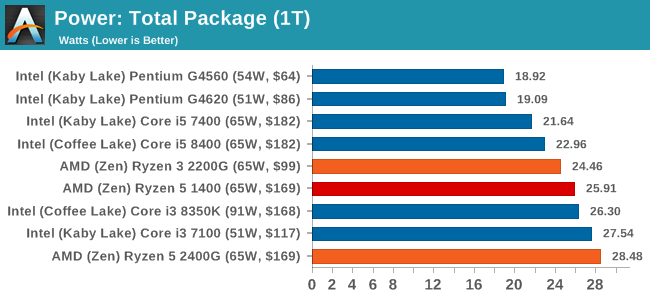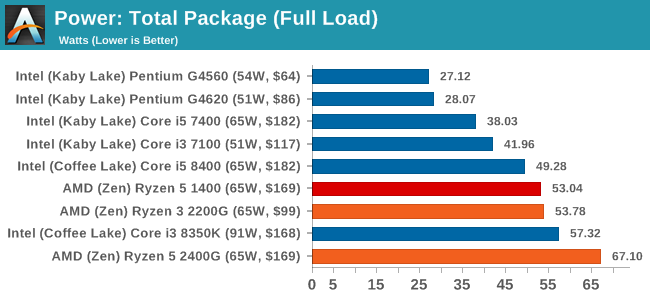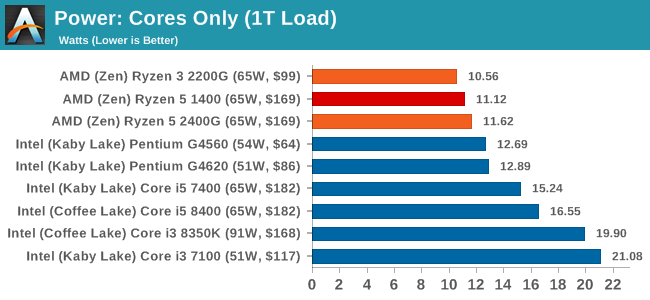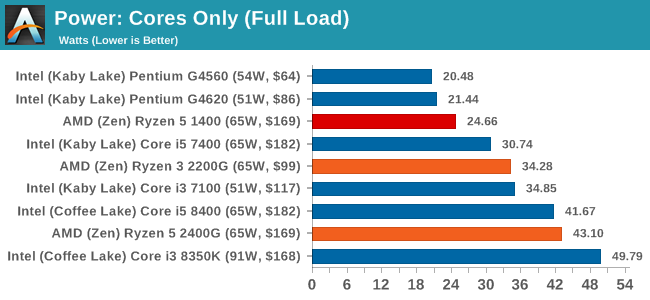Marrying Vega and Zen: The AMD Ryzen 5 2400G Review
by Ian Cutress on February 12, 2018 9:00 AM ESTPower Consumption
For our power consumption metrics, we use a Prime 95 blend on fixed threads to generate a strong load, and then poll the internal power registers that determine power state calculations to get the power consumption. Each processor is different in how it reports its power, which depends on the level of control the processor has: some of the more advanced CPUs, such as Ryzen, will provide per-core power numbers, while the latest Intel CPUs only give a figure for the CPUs as a whole but also include DRAM controller and uncore power consumption.
An interesting element to the power consumption on the Ryzen APUs, due to the unified power delivery subsystem in play feeding the CPU and the integrated graphics, is that the power registers only report half the power consumption when probed (e.g. when 14W, shows 7W). As of yet, we are unsure if this has a knock-on effect on how the processor adjusts its turbo modes in response to power consumption. Nonetheless, a simple scaling factor gives the following results.
Total Package: The Whole Processor
For this data, we take the values of the processor as a whole, which includes all the interconnect, memory controllers, PCIe root complexes, etc. The system is still only loading the CPU cores with minimal effect on the rest of the system, however depending on how the power is managed, some of the sub-systems still remain enabled.


At full load, the difference between the Ryzen 5 and the other Ryzen CPUs shows that the 2400G is using more of its upper margin, compared to the 1400 which is rated at the same power (note TDP is only determined at the base frequency), but the extra frequency of the 2400G means that there is extra power draw overall. Part of this is due to the Infinity Fabric, which we will see below. But what these tests also underline is that in a quad-core configuration, the Intel CPUs are still very power efficient.
Cores Only: Pure Work
For the processors that split out the data, we can look at the power consumption of the cores on their own, without any of the sub-systems, like uncore, mesh, or infinity fabric. This usually paints a different picture to the package power.


For the core only power, the Ryzen 5 2400G uses less power than the Core i3-8350K, despite the situation being reversed when considering the whole package. This means that Infinity Fabric takes a lot of power here, and the ring bus solution that Intel uses benefits from being simpler, and Intel can push more power to its individual cores.










177 Comments
View All Comments
Cooe - Monday, February 12, 2018 - link
Here's an article with a bunch of graph's that include the i7-5775C if you'd prefer to peep this instead of that vid.https://hothardware.com/reviews/amd-raven-ridge-ry...
Cooe - Monday, February 12, 2018 - link
Your i7-5775C isn't even as fast as an old Kavari A10 w/ 512 GCN2 SP's (it's close, but no cigar), so vs Vega 8 & 11 it gets it's ass absolutely handed to it... like by a lot - https://youtu.be/sCWOfwcYmHIjrs77 - Monday, February 12, 2018 - link
When I look at all the available benchmarks so far, then there's nothing this chip can play, that I can't allready play with my 5775C. 1080p with medium settings is no problem for most games like Overwatch, Borderlands, WoW, Diablo, etc. So if the 2400G can't run them at high settings, like it looks like, then I see no reason to call it the King of integrated graphics really.Holliday75 - Monday, February 12, 2018 - link
How on God's green Earth can you compare a $600+ CPU versus the 2400g? The whole point of iGPU is to be cheap. The 2400g out performs a CPU that costs over 3x as much in the exact area this chip was built for. Low end gaming.jrs77 - Monday, February 12, 2018 - link
$600 ?!? I paid €400 for my 5775C incl 24% VAT. So that would be $300 then.And again. I can play games in 1080p with low to medium settings just fine, so I don't see a reason to upgrade.
acidtech - Monday, February 12, 2018 - link
Need to check your math. €400 = $491.jrs77 - Tuesday, February 13, 2018 - link
Back when I bought it, the Euro and the Dollar where allmost 1:1, and to get the Dollar-price you need to subtract the 24% VAT I pay over here, so yeah, back then it was around $300. Hell, the intel list-price was $328.SaturnusDK - Wednesday, February 14, 2018 - link
So what you're saying is that you paid twice the money to have under half the graphics performance and 20% lower CPU performance of a 2400G.Graphics-wise the 5775C was pretty bad and got beaten by ALL AMD APUs at the time. It was close but it was never very good. Time has not been kind to it.
SSNSeawolf - Monday, February 12, 2018 - link
I noticed with some sadness that there's no DOTA 2 benchmarks. Was this due to time constraints or unforeseen issues? I'm crossing my fingers that DOTA 2 hasn't been dropped for good as it's a great benchmark for silicon such as this, though the other benchmarks of course do let us ballpark where it would land.Ian Cutress - Monday, February 12, 2018 - link
That's in our GPU reviews; different editors with different benchmark sets. We're looking at unifying the two.